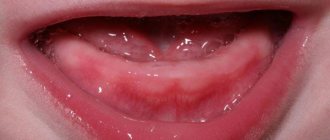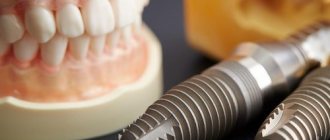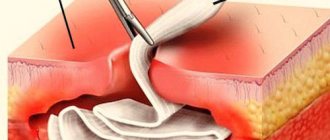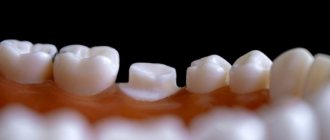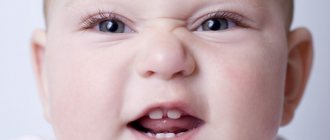Nature has provided for everything
Losing baby teeth is a natural and inevitable process that everyone goes through in childhood. Most often it begins at 5-6 years of age and passes painlessly. Sometimes the replacement of temporary teeth may begin earlier or, conversely, late. Some deviations from the usual indicators are not always considered a violation, since much depends on the health and physiological state of the child. When he begins to change his teeth, we recommend making an appointment with the dentist, as this is a very important period for the formation of your baby’s bite.
Early signs of tooth loss
Clinical manifestations of edentulism go through the precursor stage if tooth loss is not provoked by trauma.
Early signs:
- bad breath,
- increased bleeding gums,
- hypersensitivity of teeth and gums to all types of irritants,
- inflammation of the gums,
- exposure of the neck of the teeth,
- tooth mobility.
The main harbinger of edentulism is the deepening of the gum pocket. The dentist can identify pathological changes during an examination of the oral cavity.
Subsequently, disturbances in the structure and functions of the dental system are determined: malocclusion, displacement of the dentition, underdevelopment of the jaw, diction defects, deformation of the jaw bones.
What you should pay attention to
The child’s body prepares in advance for the period of teeth change. Here are the main signs of the changes taking place:
- mobility and loosening of primary teeth
- redness and swelling of the gums
- the appearance of interdental spaces due to jaw growth
- the rudiments of a permanent tooth become visible
When a baby tooth is replaced with a permanent one, the root gradually dissolves. The process is helped by a new tooth pushing out the temporary one from below.
Usually children and their parents remove the loose tooth themselves. But we recommend contacting a specialist who will provide professional assistance.
Complications
A decrease in the number of teeth disrupts the correct structure of the dentition, creates additional stress on neighboring units, which leads to the loss of healthy teeth.
The absence of several formed teeth causes a number of complications:
- bite deformation,
- formation of space between teeth,
- displacement of the lower jaw,
- increased sensitivity to cold and hot foods, drinks,
- diction defect,
- chewing dysfunction,
- increased tooth wear,
- formation of seizures on the mucous membrane and in the corners of the mouth.
Complications from the gastrointestinal tract are possible in the form of gastritis, stomach and duodenal ulcers, colitis (inflammation of the colon).
Multiple loss of teeth is accompanied by changes in appearance: the corners of the mouth are drooping, nasolabial and chin folds are pronounced. In the case of a defect in the frontal teeth, the recessed lips are visually determined; in the absence of the lateral teeth, sunken cheeks are determined. Such cosmetic defects cause psychological discomfort, negatively affect social behavior, and lower a person’s self-esteem.
In what order do teeth fall out?
The loss of baby teeth occurs in the same order in which they first erupted. First, the child loses the lower and upper incisors, then the lateral molars, and lastly the canines. The replacement of baby teeth with permanent teeth begins at the age of 5.5 years and ends at the age of 13. At the same time, instead of 20 dairy ones, 28 permanent ones grow. There is room for eight new chewing teeth due to the expansion of the jaws. By the way, wisdom teeth most often erupt in adulthood, and for some they do not grow at all.
Features of baby teeth
Now I will answer another very popular question: “how do baby teeth differ from molars?”
These are the baby's very first teeth. They appear before the age of three, and begin to erupt until there are 20 teeth. See the photo above for the cutting diagram.
They do not have such deep roots as permanent teeth, have a more rounded shape and smaller size, and are white in color, while permanent teeth have a yellowish tint. By location, they are directed vertically, and the radicals are slightly outward.
Wisdom teeth cannot be milk teeth, because they grow into deep roots only by the age of 18-20, and sometimes later.
What to do if a tooth does not fall out in time
According to statistics, in 20-30% of cases, children experience a “shark smile” when the permanent tooth has already erupted and is growing, but the milk tooth has not yet fallen out. Clinical studies have proven that in such a situation, parents should not hesitate to go to pediatric dentistry. The doctor will carefully examine your child's mouth and remove the temporary tooth. If you do not contact the dentist in a timely manner, double dentition can lead to improper formation of the bite, impaired diction and the functioning of the digestive system. In addition, with a “shark smile” it is difficult for a baby to bite and chew food, particles of which remain between the teeth and under the gum. As a result, inflammatory processes and caries occur. All this can be avoided by making an appointment with a specialist.
In dentistry, the following types are distinguished:
- Bruised tooth. It can be considered the mildest type of injury, which is provoked by blows, attempts to bite through a hard object or “taste” it, which is especially typical for children 1-3 years old.
- Tooth dislocation. Such an injury means that the tooth has moved from its usual place. Typically, this type of injury requires significant force, so it does not occur as often as bruises. There are cases of complete dislocation, when the entire tooth falls out of the socket. Modern pediatric dentistry can save even a lost tooth if there are favorable conditions for this, and parents brought their child in immediately after receiving an injury.
- Tooth fracture. Fractures are immediately visible - these are visible chippings of a corner, piece or most of a baby tooth. Most children break their front teeth; the most popular causes of such damage include fights.
- Fracture of the root or crown of a tooth. They are considered rarer species, because in normal everyday life and sports conditions it is extremely difficult to get such a deep fracture. Regardless of whether the child has acquired a simple tooth bruise or suffered a fracture, in any case it must be shown to a specialist so as not to endanger the health of the young body.
Orthodontic treatment – caring for the future
Some parents do not attach importance to the fact that the baby tooth has not yet fallen out, but the permanent one is already emerging. Or, on the contrary, the temporary one is lost early, and the tooth that replaces it does not grow. If you notice deviations, we recommend that you contact an orthodontist as soon as possible, who will provide effective treatment.
For example, with the premature loss of a baby tooth, the free space is very quickly taken up by neighboring teeth. There is not enough space for a permanent one. Therefore, it is very important when forming a temporary occlusion to fill such gaps, preventing the occurrence of an occlusion anomaly. To hold space for a permanent tooth, orthodontics uses a plate with artificial teeth. For single defects, a non-removable “ring-loop” design is most often used. The device does not cause discomfort, and the child wears it until the permanent tooth erupts.
The product manufacturing process is standard: impressions are taken, models are made, and the design is created in the laboratory within two weeks. Its fixation takes 15-20 minutes. After installing the device, you do not need to drink or eat for 2 hours. It is better to limit the consumption of “pulling” foods - toffees, chewing gum, etc.
How to behave if your child’s first tooth falls out?
The first baby tooth that falls out is another step towards growing up. So why not mark this event with some interesting ritual for the child, so that further loss will be easier for the baby and bring more joy.
Tooth Fairy
Give your baby a little magic. Let the good sorceress take the first tooth from under the pillow while he sleeps, and in return leave a small gift: candy, a coin or a toy. The next baby tooth that falls out will bring joy to the baby.
Mouse
Another tradition that children really like is to give a lost tooth to a mouse. The mouse will chew the old tooth, and a new one will appear in its place.
Together with your baby, you need to find a secluded corner in the house and put the fallen tooth there. At night, a mouse will run into the corner and take it away.
We hope that falling out baby teeth and emerging permanent teeth will not cause trouble for either children or parents. And to make the first molars give the baby even more joy, we have developed a special Asepta Teens toothpaste to protect and strengthen the enamel of permanent teeth in children over 8 years old. The paste increases the resistance of enamel to bacteria and acids, helps saturate teeth with calcium and phosphorus, and provides effective protection against caries and gum inflammation. And the rich taste of apricot, peach and cream will turn brushing your teeth into a real treat.
Doctors are our pride
We did the research and found out why they trust us. In reviews
On our website, parents note the highly qualified doctors who have knowledge of several related areas and have extensive experience
working with children
. This allows you to see the clinical picture as a whole and plan treatment correctly.
In 2022, family dentistry "DOMOSTOM" in Domodedovo entered the TOP 100 private children's dental clinics in Russia according to the rating of the expert magazine about dentistry Startsmile with the support of Kommersant Publishing House.
Our clinic’s team of professionals knows how to help your child. Sign up for a consultation with us. Attentive doctors will tell you in detail about the condition of the baby’s oral cavity and answer all questions.
Diagnostics
To recognize missing teeth, an external examination of the oral cavity by a dentist is sufficient. Establishing the causes and correcting the defect may require the advisory participation of a surgeon, orthodontist, orthopedist, implantologist, or therapist.
To identify the causes of edentulism, the dentist evaluates the condition of the teeth, determines the correspondence of the teeth to the chronological age, and the presence of concomitant pathologies.
The most informative research methods are radiography and panoramic photography (showing the upper and lower jaw). They allow you to obtain information about structural changes in tooth tissues and surrounding tissues. X-ray imaging also determines congenital defects of the dental system, the presence and absence of tooth germs, neoplasms, inflammation, and cysts.
Treatment
Lost teeth are replaced with dentures. Preliminary treatment of concomitant diseases is carried out, roots and teeth that cannot be saved are removed, and tartar is removed.
Removable prosthetics
If one or more teeth are lost, removable dentures are offered. It is preferable when there is a small number of preserved teeth and the patient does not want to treat adjacent healthy units for support. The patient can independently remove and place dentures in the oral cavity. A significant drawback is that the main load falls on the gums, and not on the jawbone, as it should normally be.
Removable prosthetics are performed using various orthopedic devices:
- Complete plate dentures. This is a nylon or plastic plate with artificial teeth attached to it. Most often used to replace completely missing teeth in the upper or lower jaw.
- Partially removable dentures. The structure consists of a basic frame, supporting and retaining devices and artificial teeth. Suitable for incomplete tooth loss, mainly for unilateral replacement of chewing units.
- Immediate dentures. Temporary structure for the period of production of a permanent prosthesis. Not intended for long-term wear. Attached to the gum by suction. After each meal, the denture must be removed and washed.
Removable prosthetics are impossible in cases of osteomyelitis (purulent lesions of the jaw bones), osteoporosis (decreased bone strength), inflammation of the oral cavity in the acute phase, and epilepsy.
Fixed prosthetics
For large dental defects, fixed prosthetics are performed:
- Bridge prosthesis. It is fixed to adjacent teeth with special supporting elements: beams, wing-shaped fasteners, fiberglass tape. Indicated for replacing no more than three missing teeth. Due to its low mechanical strength, it is not used for prosthetics of anterior teeth.
- Crowns. Used to replace 1–3 lost teeth. They require treatment of adjacent teeth to accommodate the design of the prosthesis. There are ceramic, metal-ceramic and metal-free. Color, shape and size are selected individually.
- Prosthetics supported by implants. A dental implant is a titanium rod that is implanted in place of a lost tooth and serves as a support structure for a prosthesis. Crowns made of metal ceramics, zirconium dioxide or a special alloy are installed on top. The crown is fixed with a special screw or cement. Used for both single and multiple defects in the dentition. A prerequisite for implantation is sufficient bone height and thickness.
The optimal method of prosthetics is recommended by an orthopedic surgeon, taking into account the location and number of missing units in the dental arch.
What to do if a child’s tooth falls out?
The problem of partial dental defects is solved by removable plate structures. After jaw growth stops, they are replaced with a bridge prosthesis - the structure is fixed to the adjacent teeth with special supporting elements. If all teeth are completely lost, the dentition is replaced with artificial removable dentures. Since bone tissue develops and forms before the age of 18, dentures are replaced every 2 years.
Prevention of tooth loss
It is impossible to prevent a hereditary predisposition to edentulism. Women at the stage of planning and pregnancy are obliged to provide favorable conditions for the intrauterine development of the fetus, and, if possible, eliminate all risk factors.
Thorough oral hygiene, regular preventive examination by a dentist, timely treatment of diseases of the teeth and surrounding tissues are the main preventive measures. General preventive measures include healthy eating, strengthening the immune system, and giving up bad habits.
Advice!
Particular attention must be paid to oral hygiene. In addition to toothpaste and brush, use mouthwash, irrigator and dental floss daily to clean the spaces between teeth. Change your toothbrush every three months.
In case of tooth loss, it is important to perform prosthetics as early as possible in order to prevent the loss of healthy units and displacement of the dentition.

